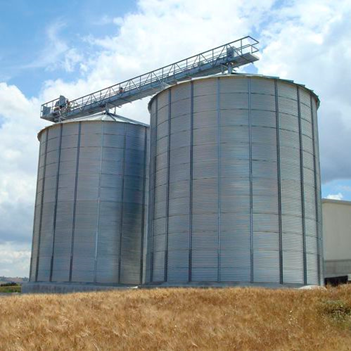As grain storage steel silos become the mainstream silos in the grain and oil industry, their safety issues have increasingly become one of the focuses of the industry. In the past 20 years, the dust explosion accident rate of grain steel silos in grain and oil processing plants and feed plants has been on the rise. Starting from the design, considering various influencing factors, and taking comprehensive prevention and control measures, it is possible to effectively control dust and prevent dust explosion accidents.
1. The overall planning and design of the steel silo follows the principle of overall fortification. The production process should be closed and automated as much as possible; special safety walls and isolation belts (such as firewalls, green belts, fire doors, etc.) should be set up for buildings and mechanical equipment with explosion hazards, and fireproof materials should be used appropriately; Grounding, anti-static and fire protection design should be fully considered and safe and reliable preventive measures should be taken.
2. In the structural design of the steel silo, the steel silo should be equipped with safety devices such as ventilation windows, explosion vents, and inspection holes to maintain the normal pressure in the silo; signal, to prevent blockage of elevators and conveyors; for places that are easily damaged (such as closed corridors, trestles, etc.), set up explosion-proof windows to achieve the purpose of explosion relief; use lightning rods or lightning belts, etc.
3. Ventilation and dust removal process design. Reasonable ventilation and dust removal process plays a positive role in preventing dust explosion. It is very important to choose the appropriate parameters and methods during design. Use dust collectors and protective covers as much as possible. Select the appropriate position of the suction point and the structure of the windshield, especially for the part where the grain is delivered, so that a wind belt can be formed with the outside world when the grain is delivered, so as to prevent dust from flying. Install a dust hood close to the dust source to limit the dust to a smaller area.
4. In the design of the grain transportation process, the process flow should be short, the equipment should be selected and arranged reasonably, with dust-proof and explosion-proof supporting devices and sealed as much as possible, and magnetic separation equipment should be used as much as possible. Secondary purification should be used for parts with high dust concentration. All electromechanical equipment shall be grounded to prevent the accumulation of static electricity.
5. In the design of electrical appliances, lamps and wires must be of the correct specifications and models, and must be explosion-proof. The motor should adopt a vibration damping device to reduce dust flying and spreading. When designing, the principle of overall fortification must be followed, and the supporting design for dust and explosion protection must be done well.
6. Adopt new dust-proof and explosion-proof technology
The spray dust suppression technology not only improves the current dust control methods, but also broadens the existing new ideas of dust control. In addition, the application of spraying water mist explosion-proof dust removal technology can effectively suppress the flying of dust, and the dust suppression effect is better, which is more suitable for grain and oil processing plants and grain transfer warehouses.
In addition to the above points, in order to effectively prevent the dust explosion of grain steel silos, while actively taking dust removal and explosion-proof measures, it is also necessary to strengthen the dust removal and explosion-proof technology management and technical training during the use of the silo.
